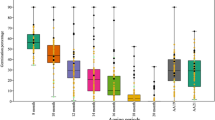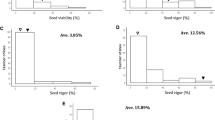Abstract
Loss of seed viability is a serious hurdle in production and ambient seed storage of soybean. Understanding the factors affecting seed viability, and identification of soybean genotype(s) with higher viability is critical for higher soybean production. In this study, seeds of 125 soybean genotypes of three different species [Glycine tomentella Hayata, Glycine max subsp. soja (Siebold & Zucc.) H. Ohashi, and Glycine max(L.) Merr.] and 25 RILs (Glycine soja × Glycine max) were tested for germination immediately after harvest followed by 1, 2 and 3 years of ambient storage. Fresh seeds of all the genotypes recorded 78–99% germination with a mean of 94.02%. However, the mean value of per cent germination of all the genotypes after 1, 2 and 3 years of ambient storage decreased and found to stand at 79.51%, 52.24% and 29.18%, respectively. Among the genotypes tested, G. tomentella accession registered highest seed storability followed by G. soja, RILs and G. max. After 3 years of storage, 14 wild type genotypes and 3 RILs found to maintain > 70% germination and, were identified as ‘good storers’. Genetic divergence studies via k-mean clustering and principal component analysis grouped all genotypes in three clusters. Seed viability was significantly and negatively correlated with electrical conductivity. Good storers found to be having slow imbibition rate than poor storers in initial hours of imbibition. The good storing genotypes identified in this study will serve as an elite soybean genetic resource in developing the soybean cultivars with better seed longevity.





Similar content being viewed by others

References
Adsul AT, Chimote VP, Deshmukh MP (2018) Inheritance of seed longevity and its association with other seed-related traits in soybean (Glycine max). Agric Res 7(2):105–111. https://doi.org/10.1007/s40003-018-0297-7
Anonymous (2013) International rules for seed testing. Published by the International Seed Testing Association. P O Box 308 8303 Bassersdorf CH-Switzerland
Chandra S, Kumar A, Lal SK, Poonia S, Rathod DR, Sipani NS, Talukdar A, Yadav RR, Yashpal, (2016) Seed viability in Soybean: donor identified and RILs Developed. In: Abstracts of 1st International Agrobiodiversity Congress, November 6–9, 2016, NASC Complex, New Delhi, India. pp. 187
Bellaloui N, Smith JR, Mengistu A, Ray JD, Gillen AM (2017) Evaluation of exotically-derived soybean breeding lines for seed yield, germination, damage, and composition under dryland production in the midsouthern USA. Front Plant Sci 8:176. https://doi.org/10.3389/fpls.2017.00176
Bhatia VS (1996) Seed longevity as affected by field weathering and its association with seed coat and pod characters in soybean. Seed Res 24:82–87
Chandra S, Yadav RR, Poonia S, Yashpal Rathod DR, Kumar A, Lal SK, Talukdar A (2017) Seed coat permeability studies in wild and cultivated species of soybean. Int J Curr Microbiol Appl Sci 6(7):2358–2363. https://doi.org/10.20546/ijcmas.2017.607.279
Chandra S, Taak Y, Rathod DR, Yadav RR, Poonia S, Sreenivasa V, Talukdar A (2020) Genetics and mapping of seed coat impermeability in soybean using inter-specific populations. Physiol Mol Biol Plants 26(11):2291–2299. https://doi.org/10.1007/s12298-020-00906-y
Concibido VC, Vallee BLa, McLaird P, Pineda N, Meyer J, Hummel L, Yang L, Wu K, Delannay X. 2003. Introgression of a quantitative trait locus for yield from Glycine soja into commercial soybean cultivars. Theor Appl Genet 106(4):575–582
Dadlani M, Agrawal PK (1983) Mechanism of soybean seed deterioration. Plant Physiol Biochem 10:23–30
Dargahi H, Tanya P, Srinives P (2014) Mapping of the genomic regions controlling seed storability in soybean (Glycine max L.). J Genet 93(2):365–370. https://doi.org/10.1007/s12041-014-0381-0
Gaikwad KB, Singh N, Bhatia D, Kaur R, Bains NS, Bharaj TS, Singh K (2014) Yield-enhancing heterotic QTL transferred from wild species to cultivated rice Oryza sativa L. PLoS One 9(6):e96939
Hahlis DA, Smith ML (1997) Basic and applied aspects of seed biology. In: Proceedings of the Fifth International Workshop on seeds. 10–15, 1995, Reading, U.K. pp 507–513
Hang NT, Lin Q, Liu L, Liu X, Liu S, Wang W, Li L, He N, Liu Z, Jiang L, Wan J (2015) Mapping QTLs related to rice seed storability under natural and artificial aging storage conditions. Euphytica 203(3):673–681. https://doi.org/10.1007/s10681-014-1304-0
Hosamani J, Kumar MB, Talukdar A, Lal SK, Dadlani M (2013) Molecular characterization and identification of candidate markers for seed longevity in soybean [Glycine max (L.) Merill]. Indian J Genet 73(1):64–71
Jiang W, Lee J, Jin YM, Qiao Y, Piao R, Jang SM, Woo MO, Kwon SW, Liu X, Pan HY, Du X (2011) Identification of QTLs for seed germination capability after various storage periods using two RIL populations in rice. Mol Cells 31(4):385–392. https://doi.org/10.1007/s10059-011-0049-z
Kuchlan MK, Dadlani M, Samuel DVK (2010) Seed coat properties and longevity of soybean seeds. J New Seeds 11:239–249
Kumar A (2005) Studies on storability and vigor parameters in soybean. M.Sc. Thesis. Division of Seed Science and Technology, ICAR-IARI, New Delhi
Kumar A, Chandra S, Talukdar A, Yadav RR, Saini M, Poonia S, Lal SK (2019) Genetic studies on seed coat permeability and viability in RILs derived from an inter-specific cross of soybean [Glycine max (L.) Merrill]. Indian J Genet 79(1):48–55
Kumar A, Talukdar A, Yadav RR, Poonia S, Ranjan R, Lal SK (2019) Identification of QTLs for seed viability in soybean [Glycine max (L.) Merill]. Indian J Genet 79(4):713–718
Liu J, Qin WT, Wu HJ, Yang CQ, Deng JC, Iqbal N, Liu WG, Du JB, Shu K, Yang F, Wang XC (2017) Metabolism variation and better storability of dark-versus light-coloured soybean (Glycine max L. Merr.) seeds. Food Chem 223:104–113. https://doi.org/10.1016/j.foodchem.2016.12.036
Metsalu T, Vilo J (2015) Clustvis: a web tool for visualizing clustering of multivariate data using Principal Component Analysis and heat map. Nucleic Acids Res 43(W1):W566–W570. https://doi.org/10.1093/nar/gkv468
Mugnisjah WQ, Shimano I, Matsumoto S (1987) Studies on the vigour of soybean seeds II: varietal differences in seed coat quality and swelling components on seed during moisture imbibition. J Faculty Agric Kyushu Univ 13:227–234
Naik SM, Madhusudan K, Motagi BN, Nadaf HL (2016) Diversity in soybean (Glycine max) accessions based on morphological characterization and seed longevity characteristics. Prog Res Int J 11(03):377–381
Rathod DR, Jyoti D, Anil K, Keya M, Deepika C, Subhash C, Lal SK, Akshay T (2015) Genomic variation studies in Glycine max and Glycine soja using SSR markers. Curr Sci 109:1929–1931
Roberts EH (1972) Viability of seeds. Chapman and Hall, London, p 448
Saman S, Heidari H, Abad S, Hamidi A, Ghorban N, Mohammadi AM (2014) Evaluation of soybean seed quality under long term storage. Int J Biosci 5:214–219
Sano N, Rajjou L, North HM, Debeaujon I, Marion-Poll A, Seo M (2015) Staying alive: molecular aspects of seed longevity. Plant Cell Physiol 57(4):660–674. https://doi.org/10.1093/pcp/pcv186
Sooganna S, Jain SK, Bhat KV, Amrit L, Lal SK (2016) Characterization of soybean (Glycine max) genotypes for seed longevity using SSR markers. Indian J Agric Sci 86(5):605–610
Tanksley SD, Grandillo S, Fulton TM, Zamir D, Eshed Y, Petiard V, Lopez J, Beck-Bunn T (1996) Advanced backcross QTL analysis in a cross between an elite processing line of tomato and its wild relative L. pimpinellifolium. Theor Appl Genet 92:213–224. https://doi.org/10.1007/BF00223378
Tiwari SP, Joshi HJ (1989) Correlation and path analysis for seed quality characters in soybean. Oil Seed Res 16:51–57
Tunwar NS, Singh SV (1988) Indian minimum seed certification standards. Central seed certification board. Department of Agri and Cooperation, Ministry of Agriculture, Government of India, New Delhi, India
Wei T, Simko V (2021) R package "corrplot": Visualization of a Correlation Matrix. (Version 0.89). https://github.com/taiyun/corrplot
Xue Y, Zhang SQ, Yao QH, Peng RH, Xiong AS, Li X, Zhu WM, Zhu YY, Zha DS (2008) Identification of quantitative trait loci for seed storability in rice (Oryza sativa L.). Euphytica 164(3):739–744. https://doi.org/10.1007/s10681-008-9696-3
Yashpal, Rathod DR, Devi J, Kumar A, Mukherjee K, Cheruku D, Chandra S, Lal SK, and Talukdar Akshay, 2015. Genomic variation studies in Glycine max and Glycine soja using SSR markers. Current Sci 109(11):1929–1931
Zhang X, Hina A, Song S, Kong J, Bhat JA, Zhao T (2019) Whole-genome mapping identified novel “QTL hotspots regions” for seed storability in soybean (Glycine max L.). BMC Genom 20(1):1–14. https://doi.org/10.1186/s12864-019-5897-5
Zhou S, Sekizaki H, Yang Z, Sawa S, Pan J (2010) Phenolics in the seed coat of wild soybean (Glycine soja) and their significance for seed hardness and seed germination. J Agric Food Chem 58(20):10972–10978
Zihad M (2013) Physiological Phenotyping of Soybean (Glycine max L. Merrill) genotypes for seed longevity. M.Sc. Thesis. Division of Seed Science and Technology, ICAR-IARI, New Delhi
Acknowledgements
First author is grateful to the UGC, New Delhi for Junior Research Fellowship (JRF) during his doctoral study and authors are grateful to the Collaborative Outstation Research Centre-Sipani Krishi Anusandhan Farm (SKAF), Mandsour, MP for providing the seed materials of the wild soybean accessions. The funding from the National Agricultural Science Fund (NASF), Indian Council of Agricultural Research, New Delhi is duly acknowledged.
Funding
Authors are grateful to the National Agricultural Science Fund, ICAR, New Delhi for funding the program.
Author information
Authors and Affiliations
Contributions
Conceptualization of research: AT, SC; Designing of the experiments: AT, SC; Contribution of experimental materials: AT, NSS; Execution of lab experiments and data collection: SC, RRY, YT, MS; Analysis of data and interpretation: SC, YT; Preparation of the manuscript: SC, AT.
Corresponding author
Ethics declarations
Conflict of interest
The authors declare that they have no conflict of interest.
Ethical approval
We declare that we have maintained the ethical standard while preparing and submitting the manuscript to the GRES.
Additional information
Publisher's Note
Springer Nature remains neutral with regard to jurisdictional claims in published maps and institutional affiliations.
Supplementary Information
Below is the link to the electronic supplementary material.
Rights and permissions
About this article
Cite this article
Chandra, S., Talukdar, A., Taak, Y. et al. Seed longevity studies in wild type, cultivated and inter-specific recombinant inbred lines (RILs) of soybean [Glycine max (L.) Merr.]. Genet Resour Crop Evol 69, 399–409 (2022). https://doi.org/10.1007/s10722-021-01240-2
Received:
Accepted:
Published:
Issue Date:
DOI: https://doi.org/10.1007/s10722-021-01240-2



